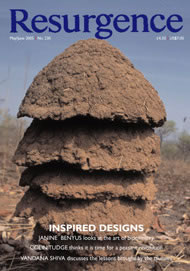THE TERM 'dead-wood' is often used to refer to 'People or things which are no longer useful'. As well as being regarded as untidy and a source of disease, dead wood is also seen as a danger to people and their property and is dealt with accordingly.
In fact the danger to humans even in this crowded island is grossly exaggerated, especially compared with other hazards such as motor vehicles and polluted air. As ever in the jaded eyes of those involved with accident and public liability insurance, nature is seen as a threat. Recent storms have shown that risks are just as likely to arise from healthy branches laden with leaves as from those which are naked!
But why should we care about dead-wood? We should care because although dead-wood might look unsightly it is one of the richest habitats in our woods and forests as well as, potentially, our parks and gardens. It occurs in several forms as dead branches on living trees, standing snags, fallen logs and branches and accumulations of twigs and small branches, and in some cases as fallen trees in situ. Dead-wood is also present in living trees with decaying cores. A fifth of Britain's invertebrates as well as several hundred species of fungi depend on dead-wood to survive.
The stag beetle (Lucanus cervus) is Britain's largest beetle and is found in southern and south-eastern England in broad-leaved woodlands, especially oak, but also in parks and gardens where there are hedgerows, tree stumps and logs. The female finds some moist decaying wood in which to lay her eggs. When she has laid her eggs, she dies, and the male does not last much longer. Each egg hatches into a creamy coloured larva, looking like a fat, wrinkly grub with an orangey-brown head and six stubby legs. It has tough jaws for tearing up and chewing decaying wood. This type of food is not very nourishing, so it takes three to five years before the larva is ready to turn into a pupa.
The adult beetle develops inside this pupal case, which remains hidden inside a decaying tree stump all through the winter. The fully formed adult beetle will not emerge until the weather becomes warmer in May or June of the following year. The cycle then starts over again, as the males fly off in search of a mate. The stag beetle is one of the many important species that help dead-wood to rot down and release nutrients back into the forest floor.
OUR FORESTS ARE presently short of dead-wood, a problem stemming from the history of forest management. In lowland woods, which historically were often intensively managed as coppice with standards, every bit of wood was used. Each tree or shrub was cut on rotation and the wood was used for making the products required by an agrarian society. The result was a dearth of deadwood. In the timber trees found within the coppice system, the dead-wood was often cut out whilst the trees themselves were harvested for constructional purposes. Where dead-wood survived was through neglect rather than intent.
The story in our western oakwoods, which are found on the old acidic rocks of the western parts of the British Isles, was equally grim for dead-wood. These woods were stripped and exploited for tan bark and charcoal production whilst anything spare was used for kindling and firewood.
Just as the era of coppicing drew to a close at the end of the nineteenth and beginning of the twentieth century, the establishment of the Forestry Commission and two world wars led to a desire for self-sufficiency and the growth in commercial production of timber in managed plantations. This in turn led to widespread planting and the 'tidying up' of woodlands. Dead-wood was, and in some cases still is, seen as harbouring diseases which might harm the final crop, and was usually treated accordingly.
There has been a recent shift in attitude and understanding towards dead-wood and its important role in forest ecology. Most professional nature conservationists are trying their hardest by promoting dead-wood in nature reserves and even in commercial woods. Under the UK Woodland Assurance Scheme the targets are three standing and three fallen stems per hectare, but this is seen by many specialists as very much a minimum figure, with 5-10 trees per hectare a more desirable level.
At Yarner Wood National Nature Reserve in Devon, English Nature has been increasing the amount of standing and fallen dead-wood as part of the management plan. Monitoring of specific areas using transect methods to measure fallen dead-wood has been introduced to ensure that quantities are increased. In some cases standing trees have been deliberately mutilated to create dead-wood niches. For those with strong aesthetic feelings this may sound sacrilegious, but it should be remembered that if it had not been for the economic exploitation of the past then this would not be necessary!
For those in less privileged positions valuable dead-wood piles can be created in gardens by leaving carefully sited brash or log piles - when it comes to dead-wood, bigger is definitely better. Also needed are greater public vigilance and understanding. Vigilance to ensure that trees are not needlessly removed for the sake of low public risk arising from a few dead branches, and understanding that dead-wood is the key to healthy live wood.







